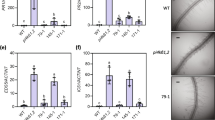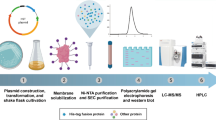Abstract
Plant vacuolar H+-transporting inorganic pyrophosphatase (V-PPase; EC 3.6.1.1) is a crucial enzyme that exists on the tonoplast to maintain pH homeostasis across the vacuolar membrane. This enzyme generates proton gradient between cytosol and vacuolar lumen by hydrolysis of a metabolic byproduct, pyrophosphate (PP i ). The regulation of V-PPase at protein level has drawn attentions of many workers for decades, but its mechanism is still unclear. In this work, we show that AVP1, the V-PPase from Arabidopsis thaliana, is a target protein for regulatory 14-3-3 proteins at the vacuolar membrane, and all twelve 14-3-3 isoforms were analyzed for their association with AVP1. In the presence of 14-3-3ν, -µ, -ο, and -ι, both enzymatic activities and its associated proton pumping of AVP1 were increased. Among these 14-3-3 proteins, 14-3-3 µ shows the highest stimulation on coupling efficiency. Furthermore, 14-3-3ν, -µ, -ο, and -ι exerted protection of AVP1 against the inhibition of suicidal substrate PP i at high concentration. Moreover, the thermal profile revealed the presence of 14-3-3ο improves the structural stability of AVP1 against high temperature deterioration. Additionally, the 14-3-3 proteins mitigate the inhibition of Na+ to AVP1. Besides, the binding sites/motifs of AVP1 were identified for each 14-3-3 protein. Taken together, a working model was proposed to elucidate the association of 14-3-3 proteins with AVP1 for stimulation of its enzymatic activity.










Similar content being viewed by others
Abbreviations
- V-PPase:
-
Vacuolar H+-pyrophosphate
- V-ATPase:
-
Vacuolar H+-ATPase
- TMs:
-
Transmembrane helices
- DDM:
-
n-Dodecyl β-d-maltoside
- Ni2+–NTA:
-
Nickel–nitrilotriacetic acid
- PMSF:
-
Phenylmethylsulfonyl fluoride
- MYTH:
-
Split-ubiquitin membrane yeast two-hybrid
- 3-AT:
-
3-Aminotriazole
References
Aitken A (2002) Functional specificity in 14-3-3 isoform interactions through dimer formation and phosphorylation. Chromosome location of mammalian isoforms and variants. Plant Mol Biol 50:993–1010
Al-Bataineh M, Li H, Marciszyn A, Bhalla V, Hallows K, Pastor-Soler N (2015) AMPK regulates the vacuolar H+-ATPase via 143-3 proteins. J FASEB 29(1 Supplement):969.23
Alsterfjord M, Sehnke PC, Arkell A, Larsson H, Svennelid F, Rosenquist M, Ferl RJ, Sommarin M, Larsson C (2004) Plasma membrane H+-ATPase and 14-3-3 isoforms of Arabidopsis leaves: evidence for isoform specificity in the 14-3-3/H+-ATPase interaction. Plant Cell Physiol 45:1202–1210
Bunney TD, van Walraven HS, de Boer AH (2001) 14-3-3 protein is a regulator of the mitochondria and chloroplast ATP synthase. Proc Natl Acad Sci USA 98:4249–4254
Camoni L, Iori V, Marra M, Aducci P (2000) Phosphorylation-dependent interaction between plant plasma membrane H+-ATPase and 14-3-3 proteins. J Biol Chem 275:9919–9923
Chevalier D, Morris ER, Walker JC (2009) 14-3-3 and FHA domains mediate phosphoprotein interactions. Annu Rev Plant Biol 60:67–91
Coblitz B, Wu M, Shikano S, Li M (2006) C-terminal binding: an expanded repertoire and function of 14-3-3 proteins. FEBS Lett 580:1531–1535
Dietz KJ, Tavakoli N, Kluge C, Mimura T, Sharma SS, Harris GC, Chardonnens AN, Golldack D (2001) Significance of the V-type ATPase for the adaptation to stressful growth conditions and its regulation on the molecular and biochemical level. J Exp Bot 52:1969–1980
Drozdowicz YM, Rea PA (2001) Vacuolar H+-pyrophosphatases: from the evolutionary backwaters into the mainstream. Trends Plant Sci 6:206–211
Efendiev R, Chen Z, Krmar RT, Uhles S, Katz AI, Pedemonte CH, Bertorello AM (2005) The 14-3-3 protein translates the Na+, K+-ATPase α1-subunit phosphorylation signal into binding and activation of phosphoinositide 3-kinase during endocytosis. J Biol Chem 280:16272–16277
Ferjani A, Segami S, Horiguchi G, Muto Y, Maeshima M, Tsukaya H (2011) Keep an eye on PP i : the vacuolar-type H+-pyrophosphatase regulates postgerminative development in Arabidopsis. Plant Cell 23:2895–2908
Fu H, Subramanian RR, Masters SC (2000) 14-3-3 proteins: structure, function, and regulation. Annu Rev Pharmacol Toxicol 40:617–647
Fuglsang AT, Borch J, Bych K, Jahn TP, Roepstorff P, Palmgren MG (2003) The binding site for regulatory 14-3-3 protein in plant plasma membrane H+-ATPase: involvement of a region promoting phosphorylation-independent interaction in addition to the phosphorylation-dependent C-terminal end. J Biol Chem 278:42266–42272
Fullone MR, Visconti S, Marra M, Fogliano V, Aducci P (1998) Fusicoccin effect on the in vitro interaction between plant 14-3-3 proteins and plasma membrane H+-ATPase. J Biol Chem 273:7698–7702
Gaxiola RA, Rao R, Sherman A, Grisafi P, Alper SL, Fink GR (1999) The Arabidopsis thaliana proton transporters, AtNhx1 and Avp1, can function in cation detoxification in yeast. Proc Natl Acad Sci USA 96:1480–1485
Gaxiola RA, Li J, Undurraga S, Dang LM, Allen GJ, Alper SL, Fink GR (2001) Drought- and salt-tolerant plants result from overexpression of the AVP1 H+-pump. Proc Natl Acad Sci USA 98:11444–11449
Gaxiola RA, Palmgren MG, Schumacher K (2007) Plant proton pumps. FEBS Lett 581:2204–2214
Gaxiola RA, Sanchez CA, Paez-Valencia J, Ayre BG, Elser JJ (2012) Genetic manipulation of a”vacuolar”H+-PPase: from salt tolerance to yield enhancement under phosphorus-deficient soils. Plant Physiol 159:3–11
Gonzalez N, Bodt SD, Sulpice R, Jikumaru Y, Chae E, Dhondt S, Daele TV, Milde LD, Weigel D, Kumiya Y, Stitt M (2010) Increased leaf size: different means to an end. Plant Physiol 153:1261–1279
Gordon-Week R, Steele SH, Leigh RA (1996) The role of magnesium, pyrophosphate, and their complexes as substrates and activators of the vacuolar H+-pumping inorganic pyrophosphatase. Plant Physiol 111:195–202
Hernandez A, Herrera-Palau R, Madronal JM, Albi T, Lopez-Lluch G, Perez-Castineira JR, Navas P, Valverde F, Serrano A (2016) Vacuolar H+-pyrophosphatase AVP1 is involved in amine fungicide tolerance in Arabidopsis thaliana and provides tridemorph resistance in yeast. Front Plant Sci 7:85
Hsiao YY, Van RC, Hung SH, Lin HH, Pan RL (2004) Roles of histidine residues in plant vacuolar H+-pyrophosphatase. Biochim Biophys Acta 1608:190–199
Huang YT, Liu TH, Lin SM, Chen YW, Pan YJ, Lee CH, Sun YJ, Tseng FG, Pan RL (2013) Squeezing at entrance of proton transport pathway in proton-translocating pyrophosphatase upon substrate binding. J Biol Chem 288:19312–19320
Huber SC, MacKintosh C, Kaiser WM (2002) Metabolic enzymes as targets for 14-3-3 proteins. Plant Mol Biol 50:1053–1063
Jaspert N, Throm C, Oecking C (2011) Arabidopsis14-3-3 proteins: fascinating and less fascinating aspects. Front Plant Sci 2:96
Kirsch RD, Joly E (1998) An improved PCR-mutagenesis strategy for two-site mutagenesis or sequence swapping between related genes. Nucleic Acids Res 26:1848–1850
Klychnikov OI, Li KH, Lill H, de Boer AH (2007) The V-ATPase from etiolated barley (Hordeum vulgare L.) shoots is activated by blue light and interacts with 14-3-3 proteins. J Exp Bot 58:1013–1023
Laemmli UK (1970) Cleavage of structure proteins during the assembly of the head of bacteriophage T4. Nature 227:680–685
Lin SM, Tsai JY, Hsiao CD, Huang YT, Chiu CL, Liu MH, Tung JY, Liu TH, Pan RL, Sun YJ (2012) Crystal structure of a membrane-embedded H+-translocating pyrophosphatase. Nature 484:399–404
Liu TH, Hsu SH, Huang YT, Lin SM, Huang TW, Chuang TH, Fan SK, Fu CC, Tseng FG, Pan RL (2009) The proximity between C-termini of dimeric vacuolar H+-pyrophosphatase determined using atomic force microscopy and a gold nanoparticle technique. FEBS J 276:4381–4394
Lo YY, Hsu SH, Ko YC, Hung CC, Chang MY, Hsu HH, Pan MJ, Chen YW, Lee CH, Tseng FG, Sun YJ, Yang CW, Pan RL (2013) Essential calcium-binding cluster of Leptospira LipL32 protein for inflammatory responses through the toll-like receptor 2 pathway. J Biol Chem 288:12335–12344
Maeshima M (2000) Vacuolar H+-pyrophosphatase. Biochim Biophys Acta 1465:37–51
Maeshima M (2001) Tonoplast transporters: organization and function. Annu Rev Plant Physiol Plant Mol Biol 52:469–497
Muslin AJ, Tanner JW, Allen PM, Shaw AS (1996) Interaction of 14-3-3 with signaling proteins is mediated by the recognition of phosphoserine. Cell 84:889–897
Obsilova V, Kopecka M, Hosek D, Kacirova M, Kylarova S, Rezabkova L, Obsil T (2014) Mechanisms of the 14-3-3 protein function: regulation of protein function through conformational modulation. Physiol Res 63:(Suppl. 1):S155–S164
Pan YJ, Lee CH, Hsu SH, Huang YT, Lee CH, Liu TH, Chen YW, Lin SM, Pan RL (2011) The transmembrane domain 6 of vacuolar H+-pyrophosphatase mediates protein targeting and proton transport. Biochim Biophys Acta 1807:59–67
Pasapula V, Shen G, Kuppu S, Paez-Valencia J, Mendoza M, Hou P, Chen J, Qiu X, Zhu L, Zhang X, Auld D, Blumwald E, Zhang H, Gaxiola R, Payton P (2011) Expression of an Arabidopsis vacuolar H+-pyrophosphatase gene (AVP1) in cotton improves drought- and salt tolerance and increases fibre yield in the field conditions. Plant Biotechnol J 9:88–99
Pathirana RD, O’Brien-Simpson NM, Veith PD, Riley PF, Reynolds EC (2006) Characterization of proteinase-adhesin complexes of Porphyromonas gingivalis. Microbiology 152:2381–2394
Sehnke PC, Delille JM, Ferl RJ (2002) Consummating signal transduction: the role of 14-3-3 protein in the completion of signal-induced transitions in protein activity. Plant Cell 14:S339–S354
Serrano A, Perez-Castineira JR, Baltscheffsky H, Baltscheffsky M (2004) Proton pumping inorganic pyrophosphatases in some archaea and other extremophilic prokaryotes. J Bioenerg Biomembr 36:127–133
Svennelid F, Olsson A, Piotrowski M, Rosenquist M, Ottman C, Larsson C, Oecking C, Sommarin M (1999) Phosphorylation of Thr-948 at the C terminus of the plasma membrane H+-ATPase creates a binding site for the regulatory 14-3-3 protein. Plant Cell 11:2379–2391
Wang Y, Xu H, Zhang G, Zhu H, Zhang L, Zhang Z, Zhang C, Ma Z (2009) Expression and responses to dehydration and salinity stresses of V-PPase gene members in wheat. J Genet Genom 36:711–720
Yaffe MB, Rittinger K, Volinia S, Caron PR, Aitken A, Leffers H, Gambin SJ, Smerdon SJ, Cantley LC (1997) The structural basis for 14-3-3: phosphopeptide binding specificity. Cell 91:961–971
Yang SJ, Jiang SS, Hsiao YY, Van RC, Pan YJ, Pan RL (2004) Thermoinactivation analysis of vacuolar H+-pyrophosphatase. Biochim Biophys Acta 1656:88–95
Yang X, Lee WH, Sobott F, Papagrigoriou E, Robinson CV, Grossmann JG, Sundstrom M, Doyle DA, Elkins JM (2006) Structural basis for protein-protein interactions in the 14-3-3 protein family. Proc Natl Acad Sci USA 103:17237–17242
Yang H, Zhang X, Gaxiola RA, Xu G, Peer WA, Murphy AS (2014) Over-expression of the Arabidopsis proton-pyrophosphatase AVP1 enhances transplant survival, root mass, and fruit development under limiting phosphorus conditions. J Exp Bot 65:3045–3053
Zhang J, Li J, Wang X, Chen J (2011) OVP1, a vacuolar H+-translocating inorganic pyrophosphatase (V-PPase), overexpression improved rice cold tolerance. Plant Physiol Biochem 49:33–38
Zhen RG, Kim EJ, Rea PA (1997) Acidic residues necessary for pyrophosphate-energized pumping and inhibition of the vacuolar H+-pyrophosphatase by N,N’-dicyclohexylcarbodiimide. J Biol Chem 272:22340–22348
Zheng J, Du GG, Anderson CT, Keller JP, Orem A, Dallos P, Cheatham M (2006) Analysis of the oligomeric structure of the motor protein prestin. J Biol Chem 281:19916–19924
Acknowledgements
This work was supported by Grants from Ministry of Science and Technology, Republic of China to R.-L. Pan (NSC 103-2311-B-007-001-MY2, NSC 104-2321-B-007-002, NSC 105-2311-B-007-011-MY2), and by the Grants of the thematic research program from Agricultural Biotechnology Research Center, Academia Sinica, Republic of China (AS 103-TP-B11).
Author information
Authors and Affiliations
Contributions
YDH and YFH performed the experiments. All authors have participated in the discussions and technique assistance during the course of this studies. YDH wrote the paper initially. CHL and RLP supervised the experimental design of this project and approved the final version of the manuscript.
Corresponding authors
Ethics declarations
Conflict of interests
The authors declare that they have no conflicts of interest with the contents of this article.
Electronic Supplementary Material
Below is the link to the electronic supplementary material.
Rights and permissions
About this article
Cite this article
Hsu, YD., Huang, YF., Pan, YJ. et al. Regulation of H+-pyrophosphatase by 14-3-3 Proteins from Arabidopsis thaliana. J Membrane Biol 251, 263–276 (2018). https://doi.org/10.1007/s00232-018-0020-4
Received:
Accepted:
Published:
Issue Date:
DOI: https://doi.org/10.1007/s00232-018-0020-4




